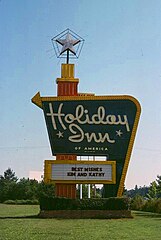I feel like I must begin this post with the correct pronunciation of Oregon. I can always tell when someone is from back east because of the way they pronounce Oregon. It is not ORE GONE. You have no idea how much that drives people from Oregon crazy. Pronounce it OR E GUN, but say it fast. Not ORE GONE. I've even heard network newscasters pronounce it incorrectly. I once had a phone call with a salesman at a large publishing company who kept pronouncing it wrong with me saying, "What? What are you talking about." And he'd say, "ore gone." I finally said, "Please spell it." "Ohhhh, you mean Oregon." Hopefully he pronounced it correctly from that point on.
Now, on to the motel.
Sadly, the La Vista Motel in Salem, Oregon no longer exists.


Click on images to see them larger.
It has been replaced by a tacky strip mall with a person in a banana suit trying to draw traffic in to one of the stores.
"The money is in the banana stand." Arrested Development
You can see from another version of the card that at some point the pool didn't exist. This card, found online, is clearly older than mine. Take a look at the old letter prefix phone number.


Click on images to see them larger.
 The real kicker for me is their sign saying you get 3 TV channels. I remember when that was a big deal. Often you were lucky if you got one channel in some out of the way places. You were often lucky to get any TV at all. Here you must have gotten the three networks. These days the signs usually say "Free HBO." Life is too cushy now.
The real kicker for me is their sign saying you get 3 TV channels. I remember when that was a big deal. Often you were lucky if you got one channel in some out of the way places. You were often lucky to get any TV at all. Here you must have gotten the three networks. These days the signs usually say "Free HBO." Life is too cushy now.I do so love the circus atmosphere around the pool with the corrugated fiberglass panels. It looks like a happy place. Kids would have been drawn to it. The parents not so much because there was probably a posted sign that said, "No lifeguard on duty."
































































